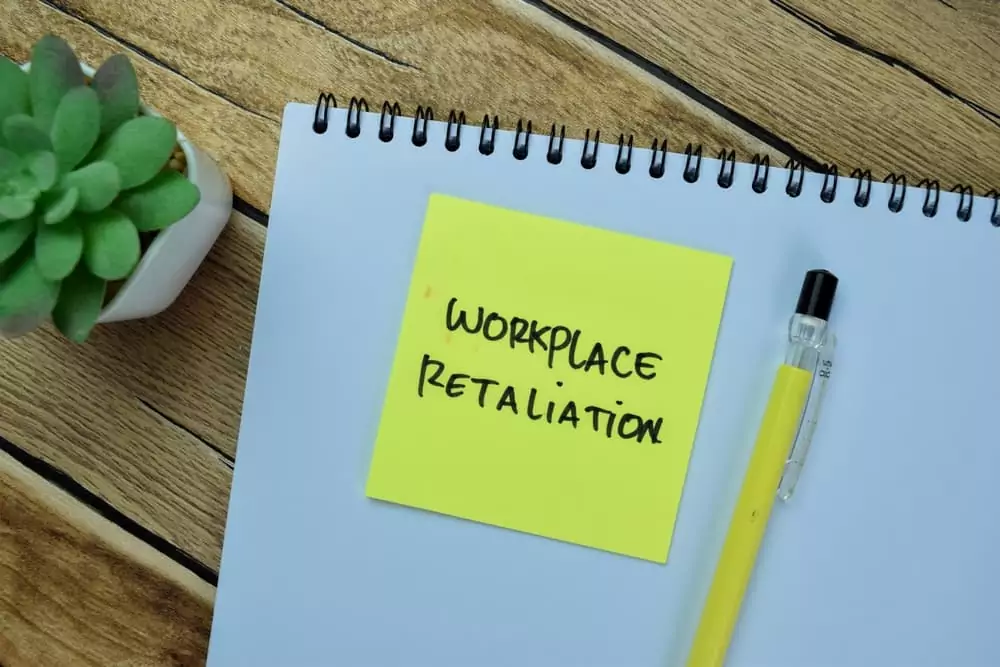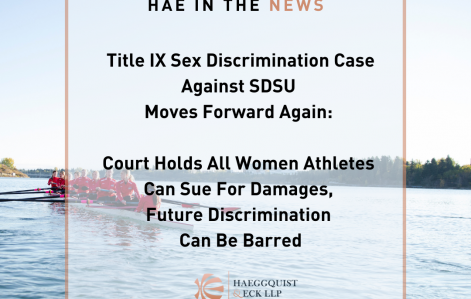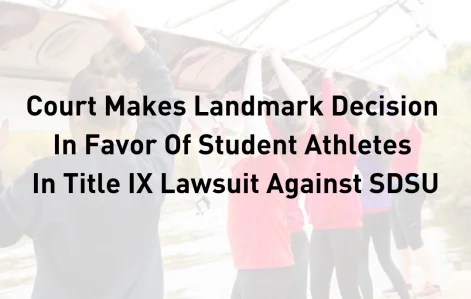Employees have important rights under state and federal law, including the right to freedom from discrimination and harassment. You may report unlawful conduct, participate in investigations regarding potential misconduct, and more.
However, what happens if you exercise your rights and your employer punishes you? If you lose your job, receive fewer shifts, or receive a less desirable assignment due to exercising your rights, it can constitute unlawful retaliation.
If you believe this happened to you, speak with a retaliation lawyer immediately. The right legal help can prove retaliation in the workplace.
Schedule a Free Initial Evaluation Today!
What Is Unlawful Retaliation by an Employer?
Unlawful retaliation at work occurs when an employer takes actions against you in response to your engagement in protected activities or exercising your legal rights. Despite laws protecting employees from such unfair treatment, many companies retaliate when an employee lodges a complaint or engages in other protected activities.
The following are the elements that characterize unlawful retaliation at work:
Protected Activity
The first crucial element of unlawful retaliation is that the employee must have engaged in a protected activity. This can include reporting workplace discrimination or harassment, filing complaints about labor law violations, participating in internal investigations, cooperating with government agencies during inquiries, requesting reasonable accommodations for disabilities, or acting as a whistleblower by reporting illegal activities within the organization.
Adverse Action
Unlawful retaliation involves the employer taking adverse actions against the employee in response to their protected activity. Adverse actions can encompass a wide range of harmful measures, such as termination, demotion, pay reduction, denial of promotions or benefits, reassignment to less desirable roles, threats, verbal abuse, unjustified negative performance evaluations, or creating a hostile work environment.
Causal Connection
To establish a claim of unlawful retaliation, the employee must demonstrate a connection between their protected activity and the adverse action taken by the employer. In other words, the employee must show that the adverse action directly resulted from their engagement in the protected activity.
Evidence tying the protected activity and the adverse action can establish a causal connection.
Knowledge of Protected Activity
The employer doesn’t need direct knowledge of the employee’s engagement in the protected activity when they take adverse action. If a lawyer can show the employer should have known about the protected activity, the employee can seek legal relief for unlawful retaliation.
Pretext
Employers may provide alternative justifications for the adverse action taken against the employee to mask their retaliatory intent. However, if the employee can demonstrate that the employer’s reasons are mere pretexts and not genuine, the claim of unlawful retaliation becomes stronger.
Pattern of Retaliation
Unlawful retaliation can reveal itself through a pattern of adverse actions against employees who engage in protected activities. If multiple employees experience adverse consequences after exercising their rights, it may indicate a culture of retaliation within the organization.
If you believe you have experienced unlawful retaliation, you should document any relevant evidence and seek legal advice promptly. Whistleblower protection laws and anti-retaliation provisions under various employment statutes safeguard you from unlawful retaliation at work and ensure a fair and just working environment for all.
What Are Protected Activities?
Protected activities at work refer to actions the law safeguards, and employees have the right to engage in these activities without facing retaliation from their employers. Various labor and employment laws establish these protected activities to ensure employees can assert their rights and participate in essential workplace activities without fear of adverse consequences.
Some key protected activities include:
- Reporting discrimination or harassment: You have the right to report any form of discrimination or harassment you experience or witness in the workplace due to factors such as race, color, sex, religion, national origin, age, disability, or other protected characteristics.
- Filing complaints: You have legal protections when you file complaints against your employer for violations of labor laws, workplace safety regulations, or other legal standards.
- Cooperating with investigations: You have the right to cooperate with government agencies, such as the Equal Employment Opportunity Commission (EEOC) or the Occupational Safety and Health Administration (OSHA), during investigations related to workplace issues.
- Requesting reasonable accommodations: If you have a disability, you have the right to request reasonable accommodations that allow you to perform your job duties effectively.
- Participating in union activities: You have the right to participate in union activities, including organizing or joining a union, without facing retaliation from your employers.
- Taking protected leave: You should have job protection when taking legally sanctioned leaves, such as those under the Family and Medical Leave Act (FMLA) or the California Family Rights Act (CFRA), for personal or family medical reasons.
- Whistleblowing: If you report illegal activities, fraud, or violations of laws within your organization or to government agencies, you have protection as a whistleblower and should not experience retaliation.
Employers should always respect and uphold their employees’ rights to engage in these protected activities. Any form of retaliation in response to these actions can lead to serious legal consequences for the employer, including paying the employee compensation.
Employers should establish clear policies and train managers and supervisors to protect their employees’ rights and make them feel comfortable coming forward with complaints or concerns without fear of retaliation. Creating a supportive and non-retaliatory work environment fosters trust, open communication, and healthy workplace culture. Unfortunately, this does not always happen, and you might need to file a retaliation claim.
For a successful claim, you must demonstrate you engaged in a protected activity, and that your employer knew about the activity. An employment attorney can gather evidence to prove that state or federal laws protected your conduct.
Examples of Adverse Actions by Employers
In addition to proving you engaged in a protected activity, you must show that your employer took adverse action against you. Unlawful retaliation by employers can take a wide range of adverse actions.
These actions punish employees for engaging in protected activities or exercising their legal rights, undermining the principles of workplace fairness and employee rights.
Below are some examples of adverse actions by employers that constitute unlawful retaliation.
Termination or Dismissal
One of the most severe forms of unlawful retaliation is terminating an employee’s employment in response to their engagement in protected activities, such as if an employer fires an employee shortly after the employee files a complaint about workplace discrimination, harassment, or other legal violations.
Demotion
Unlawful retaliation may involve demoting an employee from their current position to a lower-ranking or less desirable role as a consequence of their protected activity. This can result in reduced pay, benefits, and career advancement opportunities.
Pay Reduction
An employer engaging in unlawful retaliation might decrease an employee’s pay or benefits as a punitive measure for engaging in protected activities or asserting their rights. This can include cutting bonuses, incentives, or other forms of compensation.
Denial of Promotions or Advancements
If an employer withholds promotions or opportunities for career advancement due to an employee’s participation in protected activities, it constitutes unlawful retaliation. Such actions hinder an employee’s professional growth and development.
Harassment and Hostile Work Environment
Creating a hostile work environment or subjecting the employee to ongoing harassment, intimidation, or threats as a response to their protected activity is a form of unlawful retaliation.
Negative Performance Evaluations
Providing unjustified negative performance evaluations to an employee who has engaged in protected activities is a retaliatory action that can harm the employee’s reputation and career prospects.
Reassignment to Undesirable Tasks or Locations
Employers may retaliate against an employee by transferring them to less desirable job duties or relocating them to less favorable work locations as a form of punishment.
Threats and Intimidation
Using threats or intimidation to dissuade an employee from participating in protected activities is a direct violation of anti-retaliation laws.
Blacklisting or Disciplinary Actions
Unlawful retaliation can also involve blacklisting an employee, making it difficult for them to find new employment, or imposing unwarranted disciplinary actions.
Spreading False Rumors
Employers who engage in retaliation may spread false rumors about the employee to tarnish their reputation and credibility within the organization or industry.
Withholding Benefits
Refusing to provide benefits or perks due to an employee’s engagement in protected activities constitutes unlawful retaliation.
Unwarranted Surveillance
Excessive or unwarranted surveillance of an employee who engaged in protected activities can constitute a retaliatory action.
Unlawful retaliation is not always as dramatic as wrongful termination. It can take subtle forms. If you believe you are experiencing retaliation at work, seek legal counsel to understand your rights and options. The right attorney can advise you of the best course of action and help you prove you suffered unlawful retaliation.
Pretextual Reasons as a Defense Against Retaliation Claims
In an unlawful retaliation case, a pretextual reason refers to a false or misleading justification an employer provides to mask their true retaliatory motive for taking adverse actions against an employee. It occurs when an employer claims a seemingly legitimate reason for the adverse action, but the actual motive behind the action is to punish the employee for engaging in protected activities or asserting their legal rights.
Employers engaging in retaliation may attempt to provide alternative reasons for their actions to avoid legal consequences and create the appearance of fairness. However, these explanations are often mere pretexts and not genuine. The primary purpose of presenting a pretextual reason is to shift the focus away from the actual retaliatory intent and make it more challenging for the employee to prove their claim of unlawful retaliation.
For example, suppose an employee has recently filed a complaint against their supervisor for sexual harassment. Shortly after the complaint, the employer gives the employee a negative performance review, claiming that the employee’s work quality has declined and they are not meeting expectations.
In reality, the employer’s actions might be a response to the complaint and an attempt to retaliate against the employee for reporting the harassment. The claim their work has declined is a pretextual reason that the employer uses to justify the adverse action.
To establish an unlawful retaliation claim based on pretextual reasons, the employee must provide evidence that demonstrates:
- The employee engaged in protected activities or exercised their legal rights.
- The employer took adverse actions against the employee.
- The employer’s provided reason for the adverse action is false or misleading, and the real motive was retaliatory.
- There is a causal connection between the protected activity and the adverse action.
Proving pretext requires you to show that your employer’s reason is not credible and that retaliation was the actual motive.
To do so, the employee may rely on evidence such as:
- Timing – Demonstrating a close temporal relationship between the protected activity and the adverse action can be compelling evidence of pretext.
- Inconsistencies – Identifying inconsistencies in the employer’s explanations or comparing the treatment of other employees in similar situations can support a claim of pretext.
- Retaliatory statements – Any evidence of supervisors or management expressing a desire to retaliate against the employee can be crucial in establishing pretext.

In unlawful retaliation cases, consulting an experienced employment attorney is always beneficial. An experienced lawyer can gather evidence, assess the strength of your claim, and develop a strong legal strategy to counteract pretextual reasons and pursue justice for you.
You do not have to worry about how to prove retaliation when you have the right attorney handling your claim. They will handle everything for you.
Never ignore misconduct by your employer. You deserve a healthy and fair work environment without fear of retaliation.





